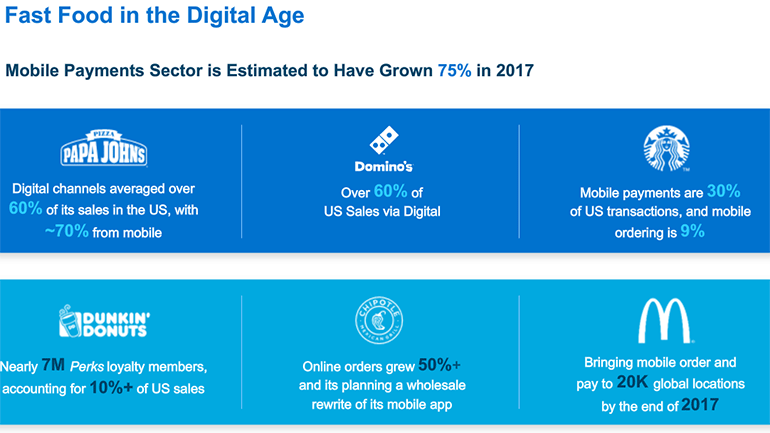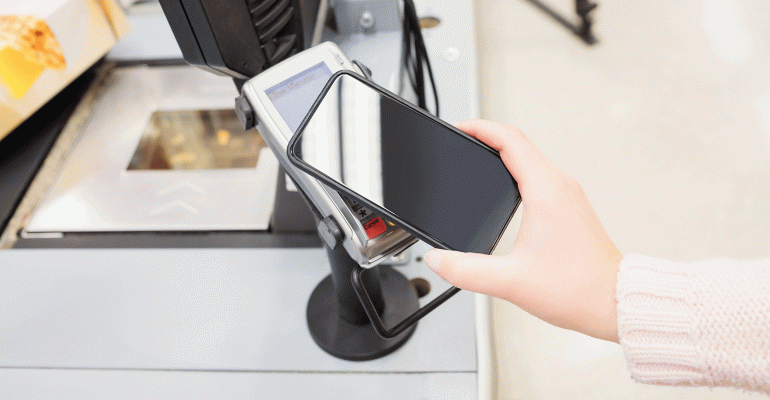Mobile-payment capabilities swept the quick-service restaurant sector in 2017, and the trend is expanding, according to a leading payments technology company.
“What made 2017 so impressive was that it felt more like a tipping point as mobile payments raced across the fast food industry,” said Glenn Fodor, head of strategic intelligence at Atlanta-based First Data Corp. “Almost all the major brands now offer services at scale: McDonald’s, Burger King, Quizno’s, Chick-fil-A, Krispy Kreme, Baskin-Robbins.”
Industry analysts estimate the volume of mobile payments in the restaurant industry grew 75 percent this year, Fodor said Wednesday in a First Data “Top 10 Trends in the Payments Industry” webinar.
“Future projections are massive: As much as 10 percent of all fast-food sales may be made via mobile in just a few years,” Fodor said.

The increase in mobile payments has been especially acute among quick-service operators, but that trend is expected to spread to other restaurant segments, he said.
“We are seeing this everywhere, from pizza to coffee to burgers and beyond,” Fodor noted. “Pizza alone is one of the emerging and most cutting-edge categories out there with respect to digital. Papa John’s and Domino’s, for example, have more than half of their sales coming from digital – very impressive.”
Dallas-based Pizza Hut, a division of Yum Brands Inc., also updated its smartphone app with delivery tracks and features like Visa Checkout, which it added in 2016.
The mobile payment moves in quick-service restaurants in 2017 set the stage for implications in other segments in 2018 and beyond, Fodor said. Those implications will be in casual-dining and convenience stores as well as traditional retailers.
Seattle-based Amazon.com’s purchase of Whole Foods Market sent a signal to all of retailing about the future of e-commerce, Fodor said.
“The grocery industry will continue to evolve,” Fodor said.
One immediate impact, he added, will be margin pressures on traditional grocers as the Amazon-Whole Foods merger increases both brands’ buying power.
“They have discounting potential,” Fodor said. “Traditional grocers are going to have to decide how they invest in expanding their e-commerce offerings. All that will incur costs, as well as investing in delivery options in-house or through third-party services.”
Other merchants, from electronics and toys to pet supplies and household goods, are facing similar pressures, he said.
Voice-activated shopping, through Amazon’s Alexa, Google Home and Apple’s HomePod, will accelerate the move to mobile payments as well, Fodor said.
“We’re really only getting started,” he said. About three million of the voice-activated devices were shipped in 2017, Fodor noted, but that is expected to rise to 15 million by 2020. Because of language barriers, most of the growth has been in the United States.
With the migration to online shopping and mobile payments, the cybersecurity threats remain a trend as well, Fodor said. A 2017 breach at Equifax, the credit-reporting agency, affected more than 143 million individuals.
“According to the most recent cyber crime report from Threat Metrics, attack levels have grown significantly in 2017,” he said.
In September, for example, Oklahoma City-based Sonic Corp., with 3,500 locations, reported a breach that affected millions of customer credit and debit card numbers.
This year also saw breaches reported at Arby’s, Chipotle Mexican Grill Inc., Pizza Hut, Shoney’s and other restaurant companies.
“As the digital frontier continues to expand, cyber security must be a top priority,” Fodor said. “And seemingly even benign data needs to be secured and protected.”
First Data serves about six million business locations and 4,000 financial institutions in more than 100 countries.
Contact Ron Ruggless at [email protected]
Follow him on Twitter: @RonRuggless

